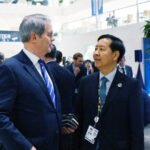SK Ecoplant headquarters in Seoul (By Dae-chul Lim)
SK Ecoplant Co., a South Korean construction engineering and waste management company, is set to merge a profit-making technology subsidiary of the parent SK Group as the country’s second-largest conglomerate is seeking to streamline its business to focus on promising growth sectors.
The restructuring, along with SK Ecoplant’s merger with SK Materials Airplus Inc., the group’s other profitable unit, is expected to accelerate the builder’s initial public offering, industry sources said on Tuesday.
SK Inc., the group’s holding company, and SK Ecoplant plans to discuss the construction unit’s takeover of the consumer memory and storage maker Essencore Ltd. of SK S.E.Asia Pte., Singapore-based special purpose company wholly owned by SK Inc., according to the sources in Seoul.
The holding company is likely to hand over Essencore to SK Ecoplant while taking a stake in the builder formerly SK Engineering & Construction Co., the sources said. SK Materials Airplus, a subsidiary of SK Material Co., is poised to become SK Ecoplant’s subsidiary.
Essencore headquartered in Hong Kong manufactures SD cards and USB flash drives with DRAM and NAND flash memory chips supplied by SK Hynix Inc., the group’s semiconductor giant.
Essencore reported an operating profit of 59 billion won ($42.6 million) last year as the stable supplier and strong sales networks helped the company cope with the semiconductor industry downturn. Its profit totaled 112 billion won in 2021 when the global chip industry boomed.
FUTURE GROWTH DRIVE IN AI DATA CENTER BUSINESS
The conglomerate expected the merger to create a synergy with SK Tes as the subsidiary of SK Ecoplant, which sells used IT devices and data center servers after maintenance to some of Essencore’s customers, can share sales and logistics networks.
SK Materials Airplus is predicted to handle the design and installation of gas pipes when SK Ecoplant constructs artificial intelligence (AI) data centers and other plants, the industry sources said.
“SK Ecoplant is seeking a future growth drive in the AI data center construction business,” said one of the sources. “Once the business restructuring is completed, SK Ecoplant will be one of the three cores along with SK Hynix and SK Telecom for the group’s AI strategy.”
SK Hynix, the world’s second-largest memory chipmaker, is the leading global manufacturer of high-bandwidth memory (HBM) chips, core semiconductors in powering AI devices. SK Telecom Co., South Korea’s top mobile carrier, works on various AI businesses.
GROUP RESTRUCTURING
SK Group has been seeking reorganization to focus on future growth engines such as batteries and chips.
The conglomerate plans to revive sluggish units such as SK On Co., the world’s fifth-largest electric vehicle battery maker, and SK Ecoplant by adding profitable units to them.
SK On displays models of electric vehicles equipped with its batteries at an industry fair on March 6, 2024, in Seoul (File photo by Dae-chul Lim)
SK On’s parent SK Innovation and the group’s clean energy unit SK E&S Co. are scheduled to decide on their merger at board meetings on Wednesday, according to industry sources. The merger is expected to create a mega energy company with an asset of 100 trillion won.
The group aims to improve the financial structure of SK Innovation deteriorated due to support to the loss-making battery maker by merging with SK E&S, which generated an operating profit of 1.3 trillion won last year.
SK E&S is likely to become an independent company of SK Innovation through the horizontal merger, sources said.
SK Innovation, South Korea’s top energy company operating the largest refiner, is seeking to merge SK On with SK Trading International Co., its oil and petroleum product trading unit, and SK Enterm Co., its tank terminal unit.
SK Trading International reported an operating profit of 574.6 billion won in 2023 and sales of 49 trillion won. The merger of the energy trading company is expected to help SK On cope with the sustained weakness in the global EV demand,
The battery maker logged an operating loss of 331.5 billion won in the first quarter after a deficit of 581.8 billion won last year. EV sales of its major customers such as Hyundai Motor Co., Kia Corp. and Ford Motor Co. rebounded but they are not strong enough for SK On’s turnaround.
SALES OF LOSS-MAKING UNITS
SK Group has been seeking to sell some of its 219 affiliates to streamline the organization. Only six companies out of 23 firms, in which the conglomerate’s investment unit SK Square Co. holds stakes, made profits last year.
SK Square is in talks with a South Korean grocery delivery platform Oasis Corp. to sell its online retail platform 11Street Co.
11Stret logistics center in South Korea (File photo)
SK Innovation selected a manager to handle a sale of a stake in its battery materials maker SK IE Technology Co. earlier this month.
The group is also speeding up its move to drop some overseas businesses. SK Inc. is in negotiations to sell a 9% stake in Masan Group Corp., Vietnam’s No. 2 private business group, while taking steps to dispose of its stake in Vingroup Joint Stock Company, the country’s top conglomerate.
In February, SK Earthon Co., SK Innovation’s resources development subsidiary, sold a stake in Peru LNG Co. LLC for $256.5 million to MidOcean Energy.
By Woo-Sub Kim, Ji-Eun Ha and Hyung-Kyu Kim
duter@hankyung.com
Jongwoo Cheon edited this article.















